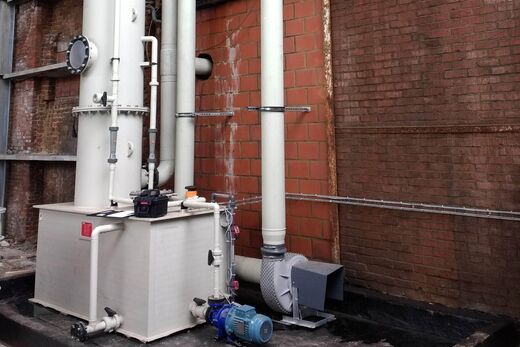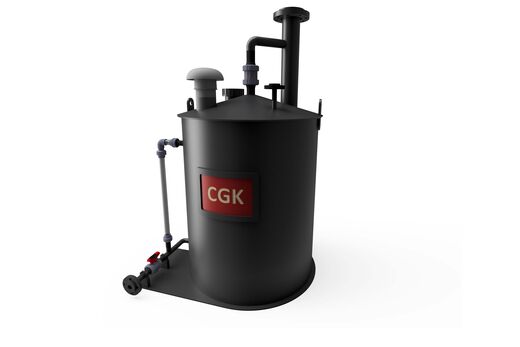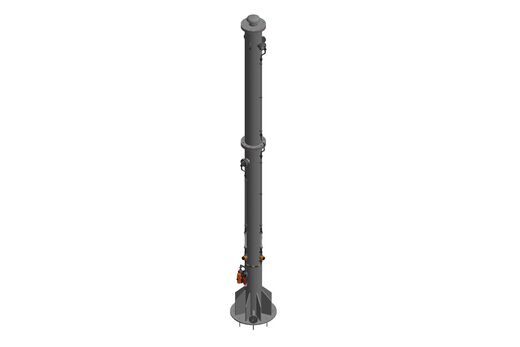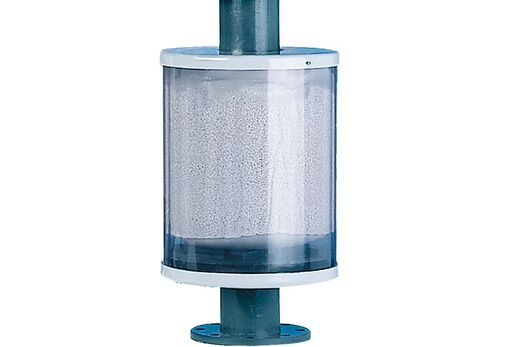Gas scrubbers: operation & legislation
A scrubber is a purification system for harmful gases. Products such as hydrochloric acid (HCl), acetic acid and ammonia (NH3) fume strongly at ambient temperature and are harmful to humans and the environment. A scrubber neutralises these vapours after they come out of the tank vent.
Een gaswasser is een reinigingsinstallatie voor schadelijke gassen. Producten als zoutzuur (HCl), azijnzuur en ammoniak (NH3) dampen sterk bij omgevingstemperatuur en zijn schadelijk voor mens en omgeving. Een gaswasser neutraliseert deze dampen nadat ze uit de tankontluchting komen.
Werking van gaswassers
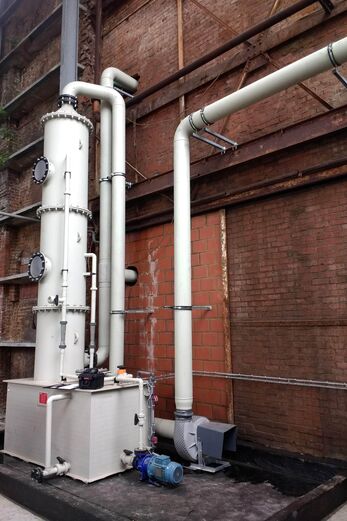
When do I need a scrubber?
- The harmful effect of the medium on humans or the environment determines whether a scrubber is needed or not.
- The volatility (vapour pressure) of the medium at the conditions used (temperature, humidity, etc.) is also a determining factor. The use of a scrubber is required by law (5.17.4.1.9 VLAREM II) at a vapour pressure from 13.3 kPa and at a temperature from 35°C. Products with a high vapour pressure evaporate faster and therefore require a scrubber.
- The relative density at 20°C of the saturated vapour or air mixture is a third important factor. If the density is between 0.9 and 1.1, the vapours can easily mix (dissolve) with air and a scrubber is recommended.
De techniek van gaswassing kan toegepast worden voor veel emissies (gasvormig). De gaswasser brengt een gasstroom intensief in contact met een bepaalde stof: water, actieve kool, basen, biofilters ... Deze stof kan bijgevolg bepaalde componenten (dampen) uit het gas absorberen. Afhankelijk van zijn debiet raakt de stof echter verzadigd waardoor vervanging of regeneratie nodig is.
Gaswassing wordt ook absorptie genoemd en is dus in feite de overgang van componenten van de gasfase naar de vloeistoffase.
Aan de hand van een diepgaande analyse installeren wij voor jou het meest geschikte gaswassingsysteem.
Operation of gas scrubbers
Wanneer heb ik een gaswasser nodig?
The technique of gas scrubbing can be applied for many emissions (gaseous). The scrubber brings a gas stream into intensive contact with a certain substance: water, activated carbon, bases, biofilters ... Consequently, this substance can absorb certain components (vapours) from the gas. However, depending on its flow rate, the substance becomes saturated, requiring replacement or regeneration.
Gas scrubbing is also called absorption and is thus basically the transition of components from the gas phase to the liquid phase.
There are different types of gas scrubbers. When choosing the right scrubber, you need to consider a number of crucial factors so that the air can be completely cleared of harmful vapours. On the basis of an in-depth analysis, we install the most suitable gas scrubbing system for you. a passive scrubber, an active scrubber (with circulation) or a filter.
- De schadelijke invloed van het medium op mens of milieu bepaalt of een gaswasser nodig is of niet.
- Ook de vluchtigheid (dampspanning) van het medium bij de gebruikte omstandigheden (temperatuur, luchtvochtigheid …) is bepalend. Het gebruik van een gaswasser is bij wet verplicht (5.17.4.1.9 VLAREM II) bij een dampspanning vanaf 13,3 kPa en bij een temperatuur vanaf 35°C. Producten met een hoge dampspanning gaan sneller verdampen en hebben daarom een gaswasser nodig.
- De relatieve dichtheid bij 20°C van het verzadigd damp- of luchtmengsel is een derde belangrijke factor. Als de dichtheid tussen de 0.9 en 1.1 ligt, dan kunnen de dampen zich gemakkelijk met lucht mengen (oplossen) en is een gaswasser aangeraden.
Passive scrubber
Types gaswassers
Er bestaan verschillende types gaswassers. Bij het kiezen van de juiste gaswasser moet je rekening houden met een aantal cruciale factoren zodat de lucht volledig kan ontdaan worden van de schadelijke dampen. Aan de hand van onze gemaakte analyse kan bepaald worden om al dan niet een passieve gaswasser, een actieve gaswasser of een filter te plaatsen.
A passive scrubber can be used under certain conditions at low tank flow rates for e.g. hydrochloric acid (HCL) or acetic acid.
The passive scrubber consists of a tank usually filled with water. Chemically laden air is passed through the water to neutralise the air. The neutral air then leaves the scrubber through the connection in the roof.
A major advantage of a passive scrubber is its simplicity: only on a regular basis, the liquid needs to be changed. So no pump or control is needed. The liquid can freeze, but you can easily avoid this by discharging it in winter, insulation and tracing or adding glycol to the water.
The contaminated water has to be processed by a wastewater treatment plant or can be used in a particular process. Water consumption depends mainly on the solubility of the medium to be washed, the odour threshold and the flow rates to be processed.
Passieve gaswasser
Active scrubber
Een passieve gaswasser kan onder bepaalde omstandigheden gebruikt worden bij lage debieten van de tank voor bv. zoutzuur (HCL) of azijnzuur.
De passieve gaswasser bestaat uit een tankje dat meestal met water gevuld is. De chemisch beladen lucht wordt doorheen het water geleid om de lucht te neutraliseren. De neutrale lucht verlaat vervolgens de wasser doorheen de aansluiting in het dak.
Een groot voordeel van een passieve gaswasser is zijn eenvoud: enkel op regelmatige basis moet de vloeistof ververst worden. Er is dus geen pomp of sturing nodig. De vloeistof kan wel bevriezen, maar dat kan je gemakkelijk vermijden door deze te lozen in de winter, isolatie en tracing of glycol toe te voegen aan het water.
Het verontreinigde water dient verwerkt te worden door een afvalwaterzuivering of kan gebruikt worden in een bepaald proces. Het waterverbruik hangt voornamelijk af van de oplosbaarheid van het te wassen medium, de geurdrempel en de te verwerken debieten.
Active gas excel especially at higher flow rates or very strong-smelling products such as ammonia 24%. Active scrubbers can handle any substance (HCl, acetic acid, NH3, HNO3, HF or SO2). Ditto for the cleaning fluid, from water to bases and acids.
In an active scrubber, air enters the column at the bottom, while nozzles atomise cleaning fluid at the top. Air and liquid flow against each other, washing the dirty air. The supply of water for the cleaning fluid occurs at two 2 levels: approximately in the middle of the scrubber and quasi at the top. Atomising the cleaning fluid is done on top of the gasket in each case.
Active scrubbers also remain fully atmospheric, with less risk of overpressure due to frozen liquid. The liquids go through water treatment after the process or are still used in another process. The consumption of water and cleaning product is higher than for a passive scrubber, though.
Actieve gaswasser
Active scrubber with circulation
the active scrubber with circulation works just like our standard active scrubber. The big difference is that the rinse water is reused for a certain time. The scrubber therefore includes a circulation pump, pH measurement, etc.
This type requires a thorough study of your situation.
Actieve gaswassers excelleren vooral bij hogere debieten of zeer sterk geurende producten zoals ammoniak 24%. Actieve wassers kunnen met elke stof overweg (HCl, azijnzuur, NH3, HNO3, HF of SO2). Idem voor de reinigingsvloeistof, van water tot basen en zuren.
Bij een actieve gaswasser komt de lucht onderaan de kolom binnen, terwijl sproeiers bovenaan reinigingsvloeistof vernevelen. Lucht en vloeistof stromen tegen elkaar, waardoor de vuile lucht wordt gewassen. De toevoer van water voor de reinigingsvloeistof gebeurt op twee 2 niveaus: ongeveer in het midden van de wasser en quasi bovenaan. Het vernevelen van de reinigingsvloeistof gebeurt telkens bovenop de pakking.
Actieve wassers blijven ook volledig atmosferisch, met minder kans op overdruk door bevroren vloeistof. De vloeistoffen gaan na het proces door de waterzuivering of worden nog in een ander proces gebruikt. Het verbruik van water en reinigingsproduct ligt wel hoger dan bij een passieve gaswasser.
Vapour filter
Actieve gaswasser met circulatie
As a simple alternative, a filter is sufficient for smaller tanks. We place the filters on the vents of the tanks.
Our filters are a plastic or stainless steel housing filled with binders such as calcium hydrate or activated carbon that neutralise harmful vapours. Here, there are also options for air drying or sterilisation.
De actieve gaswasser met circulatie werkt net als onze standaard actieve gaswasser. Het grote verschil is dat het spoelwater voor een bepaalde tijd hergebruikt wordt. De wasser bevat daarom een circulatiepomp, een pH-meting enz.
Dit type vereist een grondige studie van jouw situatie.
Dampfilter
Gas scrubber(s) needed in your business?
Get more information or request a no-obligation quotation.
Als eenvoudig alternatief volstaat een filter voor kleinere tanks. We plaatsen de filters op de ont- en beluchtingsopeningen van de tanks.
Onze filters zijn een kunststof of inox behuizing gevuld met bindmiddel zoals kalkhydraat of actieve kool die de schadelijke dampen neutraliseren. Hier zijn er ook mogelijkheden om de lucht te drogen of te steriliseren.
Gaswasser(s) nodig in jouw bedrijf?
Krijg meer informatie of vraag een vrijblijvende offerte aan.
Tips & regulations
Heb ik een gaswasser nodig?
De noodzaak tot een gaswasser hangt af van de productvluchtigheid, de omgevingstemperatuur, de luchtvochtigheid ... Maar ook de dampspanning speelt een rol: hoe hoger de spanning, hoe sneller het product verdampt. Om de lucht 100% te zuiveren houdt het wasserontwerp rekening met allerlei factoren:
- Zit de wasser op de tankontluchting? Dan voorzie je best een onder- of overdrukbeveiliging op de tank.
- Een dampspanning van 13,3 kPA bij 35 °C? Dan is een gaswasser verplicht, zie ook 5.17.4.1.9 in Vlarem II.
- Tot slot is er de relatieve dichtheid van het verzadigd damp- of luchtmengsel bij 20 °C. Ligt ze tussen 0,9 en 1,1? Dan mengen de dampen zich makkelijk met lucht, ze lossen dus op.
